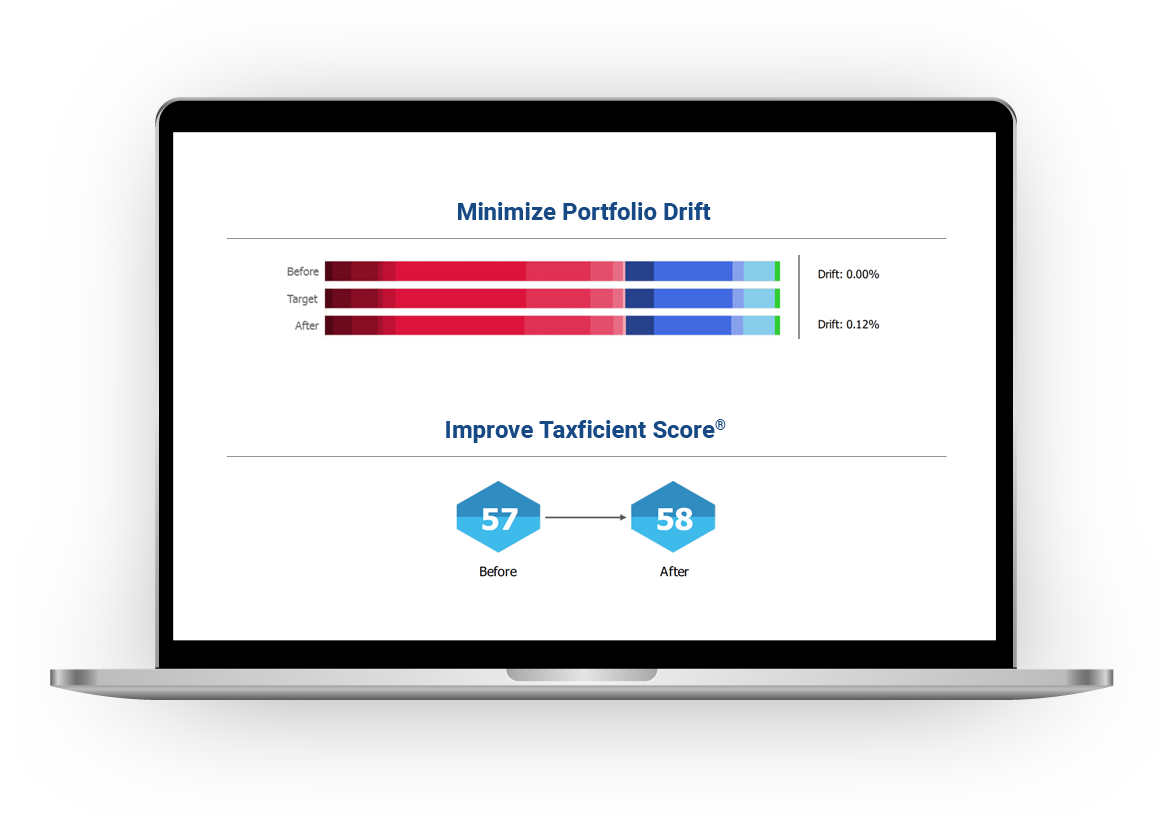Tax-Smart Withdrawals
As they approach retirement, clients will make more withdrawals from their investment accounts, but they expect you to be prepared to help them make the right decision on where to pull the money from.
Most clients who come to your firm for advice will have more than one retirement account tucked away, often because they didn’t roll over the 401(k) from a previous employer to the next. There may also be a spouse in the picture with several retirement accounts of their own, which is something that has to be factored into the household-level financial plan.
Traditionally, the process of withdrawing from one or more accounts was lengthy. Advisors were tasked with figuring out which account to pull from, how to rebalance, and how to make sure it was all tax efficient. SEI LifeYield takes the traditional guesswork out of clients’ portfolios by looking at them as a unified managed household (UMH) instead of on an individual account level.

Understanding Withdrawals, Accounts, and Taxes
The goal seems simple:
Get your client’s withdrawal from the most logical account with minimal tax events – now and in the future.
Simple, right? Not always, at least not before SEI LifeYield.
The best way to minimize the number of tax events on a financial portfolio is to look at it as a whole household, not just singular accounts.
Sure, your client may have three 401(k) accounts. Their spouse may also have an IRA and two additional 401(k)s. Instead of trying to coordinate these accounts manually, your firm can use SEI LifeYield technology to look at everything as a UMH and help you and your clients make the best and most tax-efficient decision from there.
The Withdrawal
Clients take withdrawals from investment accounts for all kinds of reasons. The most common reasons are for bigger purchases – car, house, etc. Depending on the size of the withdrawal needed, more than one account may need to be withdrawn from, which means that more than one tax rate may be applied.
There are two types of accounts in the investment world that your client can leverage for withdrawals – qualified and non-qualified. The qualified accounts are the ones that receive special tax treatment (deferred tax status or tax exemption). Non-qualified accounts are those accounts like a brokerage account with stocks, bonds, etc., that are not tax-advantaged.
When it comes to the withdrawing process, which one makes the most sense to pull from? It’s not an easy decision. That is why clients look to you for the answers.
Withdrawals, especially as investors approach retirement, are one of the most common scenarios for people to draw down on investments. Unfortunately, taxes are often required on these withdrawals – and each account likely has a different tax treatment. Withdrawing money from the wrong accounts and in the wrong order could have a significant impact on a client’s taxable income. The best way to offset this as an advisor is to leverage SEI LifeYield technology to execute multi-account withdrawals at scale.
The Accounts
We touched on qualified and non-qualified accounts, but let’s talk about why looking across all accounts is more efficient than just looking at them on an individualized level.
SEI LifeYield takes your accounts and looks at them in terms of the entire withdrawal amount and the tax event each sold lot would incur. Different accounts have different rules when it comes to making withdrawals and paying taxes on the gains. SEI LifeYield’s technology runs all these calculations at once instead of an advisor manually figuring each account out individually.
To execute, you simply input a withdrawal amount and SEI LifeYield runs the scenario across all of a client’s accounts to find the best withdrawal strategy.
This is also where you can find an opportunity to look at the gains and losses across your client’s accounts. There is an opportunity when it comes to the taxes amassed from the withdrawal to offset the capital gain with the losses in a process called tax-loss harvesting. To do this manually is extremely difficult and leaves the client open to human error. This can easily be avoided by using technology.
In the past, industry technology has only been set up to support a single account at a time. Most of them don’t even take into consideration that a client may have more than one in existence. If you’re not looking at all accounts in a household when making a withdrawal and different accounts are held with multiple advisors, wash sales can occur. This is something that can be easily avoided with technology and effective communication.
Wash sales occur when a stock or asset is sold at a loss but a similar asset is then bought again within a certain period of time (30 days). When this happens, the client cannot realize the loss as a part of their tax scenario. They will end up paying the taxes on the gains that they were trying to offset with those particular losses.
The Taxes
Nobody wants to pay more taxes than they are required to. More often than not, people end up paying more in investment taxes than they need to. That was until a more unified approach became available with SEI LifeYield.
With different accounts having different tax rules, it becomes necessary to see which accounts will support the most tax-efficient withdrawal. The algorithm developed by SEI LifeYield looks at the scenario across a household and comes up with the most tax-efficient strategy for the client, ensuring the minimal amount of taxes is paid on the transaction.
Taxes come in many different shapes, sizes, and brackets. Tax rates also change. The fluctuation can make figuring out taxes on different accounts very difficult as investors approach retirement. Tax technology can help with this. If you use SEI LifeYield’s tax APIs, you’ll never have to worry about updating your tax rates or miscalculating a withdrawal.

Long-Term Capital Gains, Tax Brackets, and Roth Conversions
Capital gains are those profits that are made when selling off an asset. Short-term gains are taxed as income because they are assets that have been held for a year or less – meaning that these gains are taxed as though they are regular income.
On the other hand, long-term gains are assets that produce profit after being held for longer than a year before being sold. These long-term gains are in an entirely different tax bracket than short-term gains and are not considered the same as regular taxable income. This is an opportunity for smart investing strategies to come to the forefront and help make complex financial decisions with taxes in mind.
Long-Term Gains and The Tax Brackets
If you want to maximize tax efficiency for your clients, there needs to be some planning done regarding withdrawing, total yearly income, and their tax rates. Sure, this seems vague at the moment, but it will all reveal itself soon enough.
| Long-term Capital Gain Tax Rate |
Income: Single | Income: Married, Filing Jointly |
|---|---|---|
| 0% | $0 – $40,000 | $0 – $80,000 |
| 15% | $40,001 – $441,450 | $80,001 – $496,600 |
| 20% | $441,451 or more | $496,601 or more |
Scenario 1: Your client is single, with a total yearly income of $274,987. They come to your firm because they want to withdraw from an investment account to pay cash for a down payment on a home. They plan to take $77,000 from a long-term account for the down payment, which will make their total taxable income $351,987. Before ever taking that withdrawal, they fell into the 15% tax bracket. They are still well within this tax bracket, with some room to withdraw more at the same rate if they wanted to do so. How would you have your client proceed?
Scenario 2: It has been a rough year for a married couple that comes in to withdraw from an account for the purchase of a car. Together, they only made $54,000 for the year. The car they are looking at is $16,000, but they plan on withdrawing an additional $1,000 for the insurance increase and other minor expenses. The total income for the year would equal $71,000. What advice might you have for them?
One Possibility: Roth IRA Conversions
In either scenario, both sets of clients are well within their tax bracket. They could take additional long-term capital gain withdrawals and convert them into a Roth IRA. As long as the capital gain withdrawal is from qualified accounts, the amount falls into the long-term taxable category. In this instance, any conversion in Scenario 1 would be 15% up to $441,450, and Scenario 2 would be 0% up to $80,000.
Roth conversions can be an effective move for retirement planning if you have time for the money to grow.

Being Tax-Smart with Retirement and Withdrawals
When clients come to you, they are looking to maximize the money they have to last them through retirement. The rule of thumb thrown out into the universe is that a retiree can withdraw up to 4% each year (plus inflation) without running out of money.
Which accounts can they pull 4% from? All of them? One at a time? Whoever made this rule wasn’t quite as descriptive about where to best pull the money from to maximize returns from those accounts.
As clients near retirement age, they also begin to receive things like pensions and Social Security benefits, which (from a tax perspective) must be factored into the total income for the year before those withdrawals are made from the retirement accounts.
Maximizing Withdrawal Opportunities
Taxes can be destructive to a client’s income distribution. Until now, it was almost impossible to withdraw income from multiple accounts without it being a long and drawn-out process. Trying to determine which accounts to withdraw from to reduce the amount of unnecessary taxes being paid was no easy feat.
If money is withdrawn from the wrong accounts or in the wrong account sequence, not only could unnecessary taxes end up needing to be paid, but assets may need to be reallocated or rebalanced. This can result in costly adjustments later.
The Challenge for Firms and Advisors
It hasn’t been easy for firms or their advisors to organize and optimize multi-account withdrawals for clients. Using traditional best practices for these activities can be complex and require coordinating asset allocation and asset location by hand to minimize the burden of taxes. Attempting to use the spreadsheet method to accomplish these tasks can be time-consuming and is extremely prone to errors. To overcome this challenge and save hours for themselves and thousands of dollars for clients, advisors and firms need software to look at all accounts as a whole household, not individually.
This method is not efficient for your firm or your advisors. You can maximize the number of clients you help by using technology to look across entire household portfolios instead of single accounts. SEI LifeYield solves the problem and offers a multi-level solution that helps advisors:
- Know what to sell and when to sell it – SEI LifeYield shows what accounts to sell from and which order to sell assets in to fulfill the ideal withdrawal scenario for the client.
- Minimize drift – Traditionally, withdrawals have made drift from the target allocation inevitable, resulting in full rebalancing – SEI LifeYield automatically handles this after a withdrawal in the most tax-efficient way.
- Pay attention to asset location – Create harmony between assets and where they are located within the portfolio to improve tax efficiency and after-tax returns.
- Look for opportunities to harvest losses – SEI LifeYield brings tax harvesting opportunities to the forefront of the withdrawal process – giving advisors another tool to help raise cash efficiently for clients.
- Keep your current technology – You don’t have to replace the current technology your firm uses. SEI LifeYield was designed to work with and strengthen the tax-efficient investing capabilities currently used in your tech stack.
Using SEI LifeYield as a Solution
The SEI LifeYield Tax-Smart Withdrawal engine looks across the client’s entire household of investment assets and provides guidance on the optimal sequence of withdrawals in seconds – much different than traditional methods. Using our proprietary algorithm, both asset allocation and asset location are taken into account to minimize taxes and raise cash.
Withdrawals can be facilitated from one or multiple accounts, regardless of their tax types (tax-deferred, tax-exempt, or taxable). Hybrid scenarios are also accommodated at multiple levels.

How Tax-Smart Withdrawals Work With Other SEI LifeYield Engines
SEI LifeYield doesn’t only make withdrawals from investment accounts easier, but they also take every account your client has into consideration. Now, advisors can execute the nuances of a financial plan in a fraction of the time.
What if you could rebalance a client’s account at the same time you make a withdrawal? Not only that, but you can instantly identify the right assets and accounts to pull them from for the withdrawal, rebalance the entire household, and do it while harvesting losses to offset the gains. Impossible? Not with SEI LifeYield.
The SEI LifeYield API Library takes all this into account. It can help facilitate simple withdrawals but also leverages tax harvesting, rebalancing, and asset location throughout the process. Each engine can be used individually or together to help your firm emphasize tax efficiency and uphold the fiduciary standard of care.
The Benefits of SEI LifeYield Tax-Smart Withdrawals
Overall, SEI LifeYield makes tax-smart withdrawals standardized and cost-effective across multiple client accounts. This is done by automating the complex and time-consuming withdrawal processes that advisors have used for years. No longer do your firm’s advisors have to spend hours looking at a spreadsheet, manually figuring the cost/benefit analysis of withdrawing from each account.
By reducing the amount of taxes paid by the client, you are increasing the amount of their money they get to keep within their portfolio. This also increases your AUM and revenue over the long haul.
SEI LifeYield makes it possible to simplify and control tax-smart withdrawals across multiple accounts and different scenarios. The goal is to keep withdrawals tax-efficient, get clients the money they need, and create minimal disruption to the entire household portfolio.
For educational purposes only. This information should not be considered investment advice.
